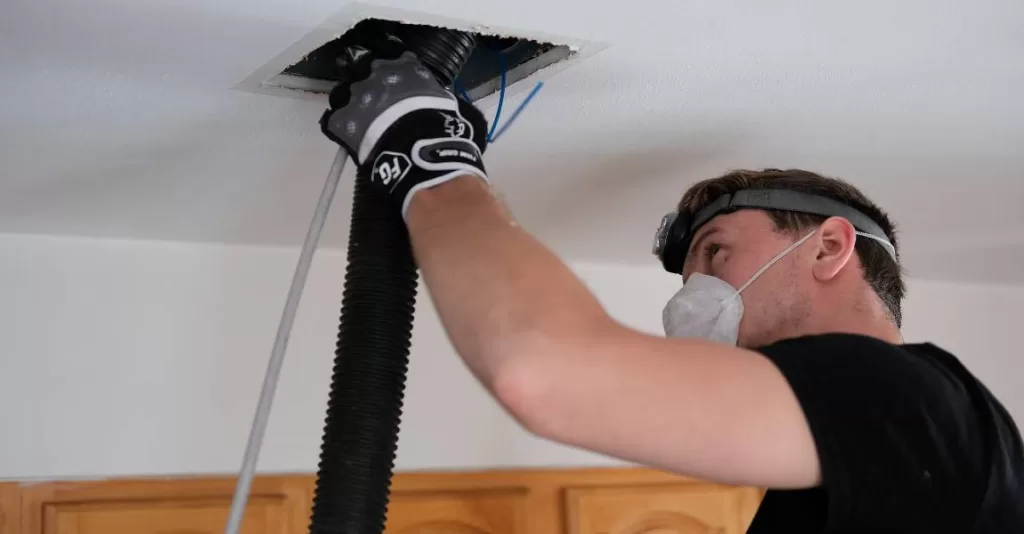
Air duct mold remediation is more important than ever in 2024, as homeowners and businesses become increasingly aware of the health risks associated with mold in their HVAC systems. Mold can thrive in damp, dark environments, making air ducts an ideal breeding ground. When disturbed, mold spores can spread throughout a building, potentially leading to respiratory issues and other health problems. This guide will delve into the essential aspects of Air Duct Mold Remediation, including prevention, detection, and remediation strategies to keep your indoor air quality safe and healthy.
Understanding Mold in Air Ducts
What Causes Mold Growth?
Mold thrives in environments that offer moisture, warmth, and organic material. In air ducts, moisture can result from a variety of sources, including:
- Humidity: High indoor humidity levels, often caused by inadequate ventilation, can create a perfect environment for mold growth.
- Leaking Ductwork: Water leaks from pipes or the roof can introduce moisture into the duct system.
- Condensation: When warm air meets cold surfaces, condensation can occur, leading to dampness in the ducts.
Understanding these causes is crucial for effective mold remediation and prevention.
Health Risks Associated with Mold
Exposure to mold can lead to a variety of health issues, particularly for sensitive individuals. Common health effects include:
- Respiratory Issues: Mold spores can irritate the lungs and exacerbate conditions like asthma and allergies.
- Skin Irritation: Direct contact with mold can lead to skin rashes or irritations.
- Fatigue and Headaches: Some people experience fatigue or headaches when exposed to mold.
Recognizing these risks emphasizes the importance of prompt action when mold is detected in air ducts.
Detecting Mold in Air Ducts
Signs of Mold Presence
Detecting mold in air ducts can be challenging, as it often grows in hidden areas. However, some signs can indicate its presence:
- Musty Odor: A persistent musty smell in the home or office often signals mold growth.
- Visible Mold: If you can see mold on the vents or inside the ducts, immediate action is required.
- Increased Allergies: If you notice an uptick in allergy symptoms, particularly when using your HVAC system, mold may be the culprit.
Testing for Mold
If you suspect mold growth, professional testing can confirm its presence. Mold testing typically involves:
- Air Sampling: Collecting air samples from various locations within the home to measure mold spore counts.
- Surface Sampling: Swabbing visible mold and sending it to a lab for analysis.
Testing can help identify not only the presence of mold but also the types of mold present, which can inform remediation efforts.
Air Duct Mold Remediation Process
Step 1: Preparation
Before remediation begins, it’s essential to prepare the area:
- Seal Off Affected Areas: Use plastic sheeting to seal off rooms and prevent mold spores from spreading.
- Turn Off HVAC System: Shutting down the HVAC system prevents the circulation of spores during remediation.
Step 2: Mold Removal
Removing mold from air ducts involves several steps:
- Vacuuming: Use a HEPA vacuum to remove loose mold spores and debris from the duct surfaces.
- Cleaning Surfaces: Clean the ducts with specialized mold remediation products or a mixture of water and detergent. It’s crucial to scrub surfaces thoroughly.
- Removal of Contaminated Materials: If the ductwork is severely contaminated, consider replacing sections of it entirely.
Step 3: Drying
Moisture removal is crucial for preventing future mold growth. Techniques include:
- Dehumidifiers: Using dehumidifiers in the affected areas to reduce humidity levels.
- Fans: Setting up fans to improve airflow and accelerate drying.
Step 4: Prevention Strategies
After remediation, implementing prevention strategies is essential to avoid future mold issues:
- Regular Inspections: Schedule routine inspections of your HVAC system and air ducts.
- Humidity Control: Keep indoor humidity levels between 30-50% using dehumidifiers and ventilation.
- Proper Insulation: Ensure ductwork is adequately insulated to prevent condensation.
Choosing Professional Help
While some homeowners may attempt DIY mold remediation, hiring professionals is often the best option. Here’s why:
- Expertise: Professionals have the training and experience to identify and remediate mold effectively.
- Equipment: Specialized equipment used by professionals can remove mold more thoroughly than typical household tools.
- Safety: Professionals follow safety protocols to protect themselves and the occupants of the building from exposure.
When selecting a mold remediation service, consider their certifications, experience, and customer reviews.
Staying Informed in 2024
In 2024, keeping up with the latest developments in air duct mold remediation is crucial. New technologies and methods are emerging, making remediation more effective and efficient. Stay informed by:
- Reading Industry Publications: Subscribe to journals and newsletters related to mold remediation and HVAC systems.
- Participating in Workshops: Attend workshops or training sessions to learn about new techniques and best practices.
Choose Go Green Heating & Cooling for HVAC Excellence in Las Vegas & Henderson
For residents of Las Vegas and Henderson, Go Green Heating & Cooling offers top-notch HVAC services that combine reliability with eco-friendliness. Whether you need regular maintenance, an emergency repair, or a new system installation, our team is committed to delivering the highest standard of service. We focus on solutions that not only keep your home comfortable but also reduce your energy costs. Visit GoGreenVegas.com or call (702) 766-1166 to schedule an appointment today and make your space more energy-efficient.



